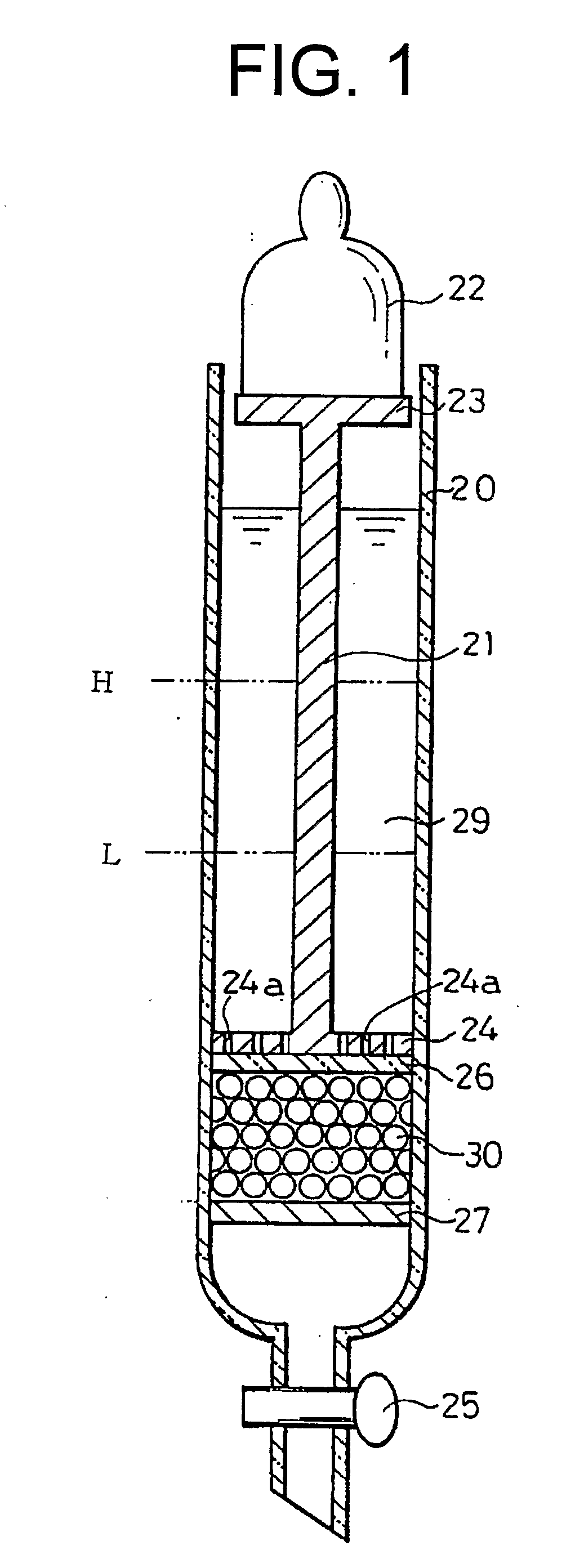Particulate water absorbing agent with irregularly pulverized shape
a technology of irregular pulverization and absorbing agent, which is applied in the direction of other chemical processes, cellulosic plastic layered products, natural mineral layered products, etc., can solve the problem of not yet satisfactorily fulfilling performan
- Summary
- Abstract
- Description
- Claims
- Application Information
AI Technical Summary
Benefits of technology
Problems solved by technology
Method used
Image
Examples
reference example 1
[0239] Polyethylene glycol diacrylate (average added mole number of ethylene oxide unit: 9) of 2.5 g was dissolved in 5,500 g of an aqueous solution of sodium acrylate having neutralization ratio of 75% by mole (monomer concentration: 38% by weight) to make reaction liquid. Subsequently, the reaction liquid was supplied to a reactor fabricated by attaching a lid to a 10-L twin-arm type kneader made of stainless steel and equipped with a jacket and two Σ-shaped agitating blades and then nitrogen gas was introduced in the reaction system to purge out dissolved oxygen, while keeping the reaction liquid at 30° C. The reaction liquid was then added with 29.8 g of a 10% by weight aqueous solution of sodium persulfate and 1.5 g of a 1% by weight aqueous solution of L-ascorbic acid while stirring the reaction liquid, resulting in initiation of polymerization after 1 minute. Peak temperature of polymerization of 86° C. was attained after 17 minutes from initiation of polymerization. After 60...
reference example 2
[0242] Polyethylene glycol diacrylate (average added mole number of ethylene oxide unit: 9) of 8.6 g was dissolved in 5,500 g of an aqueous solution of sodium acrylate having neutralization ratio of 75% by mole (monomer concentration: 38% by weight) to make reaction liquid. The reaction liquid was supplied to the reactor of Reference Example 1 and nitrogen gas was introduced in the reaction system to purge out dissolved oxygen while keeping the reaction liquid at 30° C. The reaction liquid was then added with 29.8 g of a 10% by weight aqueous solution of sodium persulfate and 1.5 g of a 1% by weight aqueous solution of L-ascorbic acid while stirring the reaction liquid, resulting in initiation of polymerization after 1 minute. Peak temperature of polymerization of 86° C. was attained after 17 minutes from initiation of polymerization. After 60 minutes from initiation of polymerization, a hydrated gel-like polymer was taken out, which polymer was in granulated state to particles with...
reference example 3
[0244] Polyethylene glycol diacrylate (average added mole number of ethylene oxide unit: 9) of 4.3 g was dissolved in 5,500 g of an aqueous solution of sodium acrylate having neutralization ratio of 75% by mole (monomer concentration: 38% by weight) to make reaction liquid. The reaction liquid was supplied to the reactor of Reference Example 1 and nitrogen gas was introduced in the reaction system to purge out dissolved oxygen while keeping the reaction liquid at 30° C. The reaction liquid was then added with 29.8 g of a 10% by weight aqueous solution of sodium persulfate and 1.5 g of a 1% by weight aqueous solution of L-ascorbic acid, while stirring the reaction liquid, resulting in initiation of polymerization after 1 minute. Peak temperature of polymerization of 86° C. was attained after 17 minutes from initiation of polymerization. After 60 minutes from initiation of polymerization, a hydrated gel-like polymer was taken out, which polymer was in granulated -state to particles wi...
PUM
| Property | Measurement | Unit |
|---|---|---|
| mass median particle size | aaaaa | aaaaa |
| pressure | aaaaa | aaaaa |
| density | aaaaa | aaaaa |
Abstract
Description
Claims
Application Information
 Login to View More
Login to View More - R&D
- Intellectual Property
- Life Sciences
- Materials
- Tech Scout
- Unparalleled Data Quality
- Higher Quality Content
- 60% Fewer Hallucinations
Browse by: Latest US Patents, China's latest patents, Technical Efficacy Thesaurus, Application Domain, Technology Topic, Popular Technical Reports.
© 2025 PatSnap. All rights reserved.Legal|Privacy policy|Modern Slavery Act Transparency Statement|Sitemap|About US| Contact US: help@patsnap.com


